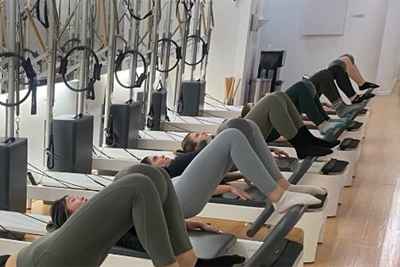Do you do Reformer Pilates?

Over the last couple of years it has been the most commonly asked question of those of us teaching the Pilates Method. Do you teach Reformer Classes?
Some years back in the noughties I first heard about a technique promising a more intense, physically challenging variation of conventional Pilates. At the time it was referred to as bootcamp or dynamic Pilates. As a relatively recently qualified Pilates Foundation teacher and card -carrying exercise junkie, I was intrigued and so went along to a newly opened studio in a smart London postcode to try it for myself. Having been immersed in Pilates as a student teacher and before that as a very keen client, I could tell immediately that it was not Pilates as I had hitherto experienced it. The founder of this particular chain was a charming ambassador for her version of ‘dynamic Pilates’ and explained that the approach was to work muscles ‘to failure’. There were at the time six or seven adapted reformers in a beautiful space that I’d last been to in a very different context, when it had been a members’ club. The vibe was very much high end, boutique style health club with funky lighting, arty shots of bare feet on tropical beaches adorning the walls and a state-of-the-art sound system. We were given a quick tutorial in how to change the springs and adjust the foot bar, then off we went.
It was completely unlike the Pilates that I knew and loved, despite many of the basic movements being the same. For a start, they used the very heavy springs used for most of the repertoire – all springs attached for footwork, for example. Then there was the fact that we did not count repetitions – our trainer used a timer to allocate how long we would spend on each exercise and it was invariably far more than I was accustomed to performing. Whilst there was certainly an emphasis on form and technique, even my inexperienced eyes could see that people around me were working in ways that would not have been encouraged in the studios in which I taught and had been trained. I likened it to circuit training on Reformers and it was to my mind, a bit of a guilty pleasure. I enjoyed the endorphin high and getting a bit sweaty. It seemed a bit like Bikram Yoga as compared to, say, an Iyengar class taught by a skilled and sensitive yoga teacher.
The classes were 55 minutes long and they were hard. I could see hyperextended knees and arms, overloaded upper traps and all manner of other indicators that the clients were regularly using already dominant global muscles and not the more subtle supporting cast ones that a good Pilates teacher would be encouraging into participation. I chose to blur out these details and have this work in lieu of gym membership. A bit like HIIT training, but with a slight flavour of Pilates. I certainly didn’t bring any of this into my work with my clients. It was something that appealed to my competitive and sporty side, rather than my Pilates teacher self. I used it to ‘get into shape’ prior to a family wedding or ski holiday. It was a bit of fun and my younger body could handle it.
That kind of class is now hugely popular, having taken the upmarket city locations by storm it is even being adopted by big gym chains. The trainers have comparatively short trainings – a few weeks is actually pretty thorough for that market. In the studio I attended there are now eleven reformers side by side (goodness knows how they do feet in straps with that many machines) and the classes seem to be regularly fully booked, for multiple sessions daily.
Last year a case came into the news of a professional musician whose career was curtailed, in her view, when one of the adapted Reformers collapsed underneath her. I was only marginally surprised to hear of this. Those machines are being heavily utilised, week in, week out. Yet still the craze continues and now every other prospective client wants to know if we do Reformer Pilates. Virgin Active is investing heavily in Pilates Reformers. The Evening Standard on 14th of March 2024 tells us that if we want a body like Margot Robbie we need to take those classes.
We need to educate our clients, new and old, that this is not what we do. Those machines are wonderful but they are spring loaded moving platforms with a lot of potential for harm if used carelessly. In our world, the Reformer is a part of a range of Pilates Apparatus and requires a skilled, trained professional to teach it safely. Working global muscles to failure on excessive springs, or indeed, doing multiple iterations of standing work on little or no springs, carry the risk of injury. One person with minimal training – at best a few short weeks – in front of a bank of up to 35 Reformers sounds very risky from a Health and Safety perspective. I’ve had a client recently report that her physiotherapist has seen a marked increase in people coming in with calcific tendonitis. Those people were recent converts to Reformer Classes. Shoulders being pushed up against pads when the platform is so heavily loaded might well become inflamed.
On the other hand, a Pilates Foundation Apparatus Teacher has been trained to teach the body in front of them, not to deliver a standardised format on repeat. We encourage a balanced musculature and do not tend to pile the springs on excessively for people to heft out and in, repeatedly, to the sounds of a modish playlist. Our teachers have trained over the long haul rather than in a matter of weeks or even days. We choose a spring resistance that will offer the right balance of challenge and support to that client on that day. Our work is far more nuanced, subtle and safe. Most of us don’t seek to teach the work for the sake of our client’s appearance, let alone to enable them to look like Harry Styles or Kate Moss. It seems journalists have progressed little in their attitudes in the decades that I’ve been reading about celebrities and their alleged chosen fitness regimes. Reformer classes are having a moment, but we need to protect our reputation from being tarnished by the inevitable injuries that will follow the mass-production of this variant of the method.
In contemplating writing this article I did think, for the purposes of up-to-date research, that I ought to go and do another Reformer Class in addition to the many classes I have attended in years gone by. The trouble is that I now really don’t think that my reactive, mildly hypermobile and menopausal body would allow me to complete it without mishap. I love any excuse for a Pilates Class and am still a movement addict, but I just did not want to take that risk. Hopefully these articles give you some flavour of how to answer the dreaded question ‘Do You Do Reformer Classes?’ and help explain how what we do in the studio is so very different from what is offered in a Reformer Class.
Ruth Walker
Pilates Foundation Board Member

